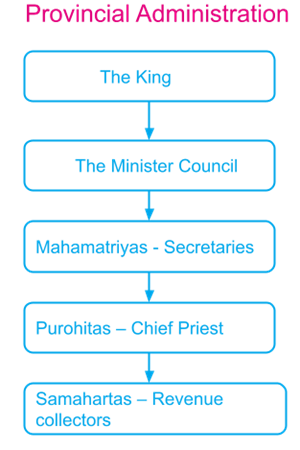PDF chapter test TRY NOW
The provincial administration of the Mauryas:
The Maurya administration was hierarchical and centralised. King was on top of the power structure, which was supported by his minister council.

The provinces of the Mauryan kingdom were administered by royal princes who served as governors. The Samhartas or revenue collectors are also added with the responsibility of keeping a record on tax revenues.
The accounts of every department are presented to the emperor by the ministers of the concerned department.
District Administration:
The next level of the Mauryan administration was the district administration which was headed by the Sthanikas, and five to ten villages were kept under Gopas. Nagarikas headed the town and city administration while the Gramani’s headed the villages under the empire.
The spy system was put in place to keep a check on intruders and the threats emerging from the external adversaries.
Judicial System:
The King was the ultimate power to issue judicial orders, while the courts also functioned in every province, which administered justice according to the severity of the crime. Punishments awarded were highly severe.
Bandhagara: The prison of the Mauryan empire was known as Bandhagaras.
The Mauryan Economy:
The Mauryan economy was dependent on agriculture and marketing the products. The revenue accrued from the agricultural products is used for the development of irrigation tanks and markets.
Taxes were levied on agriculture, land, urban settlements to improve the revenue condition of the state. The State also had a monopoly in the fields of salt manufacturing, forest and mining.
The Mauryan period also witnessed a boom in trade with Persia, Mesopotamia and the Chinese lands. The Arthasasthra also mentions Kamrup (Assam), Kasi (Benaras), Madurai and Vanga (Bengal) in its account.
Education under Mauryas:
The Mauryan administration gave substantial importance to education. Temples and monasteries served as great centres of education as the “Nalanda University in Bihar was built during the reign of the Mauryan empire”. Subjects like Grammar, Philosophy, Medicine and War science were given high importance under the Mauryan empire.

Nalanda University
The Mauryan administration gave substantial importance to education. Temples and Monasteries served as great centres of education as the “Nalanda University in Bihar was built during the reign of the Mauryan empire”.
Subjects like grammar, Philosophy, medicine and war science were given high importance under the Mauryan empire.
